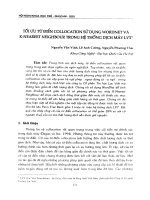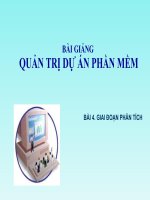Bài 4 Slide K Nearest Neighbour Classifier machine learning
Bạn đang xem bản rút gọn của tài liệu. Xem và tải ngay bản đầy đủ của tài liệu tại đây (127.42 KB, 31 trang )
K Nearest Neighbour Classifier
1
Contents
Eager learners vs Lazy learners
What is KNN?
Discussion about categorical attributes
Discussion about missing values
How to choose k?
KNN algorithm – choosing distance measure and
k
Solving an Example
Weka Demonstration
Advantages and Disadvantages of KNN
Applications of KNN
Comparison of various classifiers
Conclusion
References
2
Eager Learners vs Lazy Learners
Eager learners, when given a set of training tuples,
will construct a generalization model before receiving
new (e.g., test) tuples to classify.
Lazy learners simply stores data (or does only a little
minor processing) and waits until it is given a test
tuple.
Lazy learners store the training tuples or “instances,”
they are also referred to as instance based learners,
even though all learning is essentially based on
instances.
Lazy learner: less time in training but more in
predicting.
-k- Nearest Neighbor Classifier
-Case Based Classifier
3
k- Nearest Neighbor Classifier
History
• It was first described in the early 1950s.
• The method is labor intensive when given
large training sets.
• Gained popularity, when increased computing
power became available.
• Used widely in area of pattern recognition
and statistical estimation.
4
What is k- NN??
Nearest-neighbor classifiers are based on
learning by analogy, that is, by comparing a
given test tuple with training tuples that are
similar to it.
The training tuples are described by n attributes.
When k = 1, the unknown tuple is assigned the
class of the training tuple that is closest to it in
pattern space.
5
When k=3 or k=5??
6
Remarks!!
Similarity Function Based.
Choose an odd value of k for 2 class
problem.
k must not be multiple of number of classes.
7
Closeness
The
Euclidean distance between two points
or tuples, say,
X1 = (x11,x12,...,x1n) and X2 =(x21,x22,...,x2n), is
Min-max normalization can be used to transform a
value v of a numeric attribute A to v0 in the
range [0,1] by computing
8
What if attributes are categorical??
How can distance be computed for
attribute such as colour?
-Simple Method: Comparecorresponding value of
attributes
-Other Method: Differential grading
9
What about missing values ??
If the value of a given attribute A is missing
in tuple X1 and/or in tuple X2, we assume
the maximum possible difference.
For categorical attributes, we take the
difference value to be 1 if either one or both of
the corresponding values of A are missing.
If A is numeric and missing from both tuples X1
and X2, then the difference is also taken to be
1.
10
How to determine a good value for
k?
Starting with k = 1, we use a test set to estimate
the error rate of the classifier.
The
k value that gives the minimum error
rate may be selected.
11
KNN Algorithm and Example
12
Distance Measures
��������� ��������∶ � �, �
������� ��������� ��������∶ � �, �
���ℎ����� ��������∶ � �, �
=
��− ��
= ��− ��
2
2
= |(�� − ��)|
Which distance measure to use?
We use Euclidean Distance as it treats each feature as
equally important.
13
How to choose K?
If infinite number of samples available, the larger
is k, the better is classification.
k = 1 is often used for efficiency, but sensitive
to “noise”
14
Larger k gives smoother boundaries, better for generalization,
but only if locality is preserved. Locality is not preserved if end
up looking at samples too far away, not from the same class.
Interesting relation to find k for large sample data :
k = sqrt(n)/2
where n is # of examples
15
Can choose k through cross-validation
KNN Classifier Algorithm
16
Example
We have data from the questionnaires survey and
objective testing with two attributes (acid durability and
strength) to classify whether a special paper tissue is
good or not. Here are four training samples :
X1 = Acid Durability
(seconds)
X2 = Strength
(kg/square meter)
Y = Classification
7
7
Bad
7
4
Bad
3
4
Good
1
4
Good
Now the factory produces a new paper tissue that passes the
laboratory test with X1 = 3 and X2 = 7. Guess the classification of
17
this new tissue.
Step 1 : Initialize and Define k.
Lets say, k = 3
(Always choose k as an odd number if the number of
attributes is even to avoid a tie in the class prediction)
Step 2 : Compute the distance between input sample
and
training
sample
- Co-ordinate of the input sample is (3,7).
- Instead of calculating the Euclidean distance, we
calculate the
Squared Euclidean distance.
X1 = Acid Durability
(seconds)
7
X2 = Strength
(kg/square meter)
7
Squared Euclidean distance
7
4
(7-3)2 + (4-7)2 = 25
3
4
(3-3)2 + (4-7)2 = 09
1
4
(1-3)2 + (4-7)2 = 13
(7-3)2 + (7-7)2 = 16
18
Step 3 : Sort the distance and determine the
nearest neighbours based of the Kth minimum
distance :
X1 = Acid
X2 = Strength
(kg/square
meter)
Squared
Euclidean
distance
Rank
minimum
distance
Is it included
in
3Nearest
Neighbour?
7
7
16
3
Yes
7
4
25
4
No
3
4
09
1
Yes
1
4
13
2
Yes
Durability
(seconds)
19
Step 4 : Take 3-Nearest Neighbours:
Gather the category Y of the nearest
neighbours.
X1 = Acid
X2 =
Strength
(kg/square
meter)
Squared
Euclidean
distance
Rank
minimum
distance
7
7
16
3
Yes
Bad
7
4
25
4
No
-
3
4
09
1
Yes
Good
1
4
13
2
Yes
Good
Durability
(seconds)
Is it
Y=
included in Category of
3-Nearest
the
Neighbour? nearest
neighbour
20
Step 5 : Apply simple majority
Use simple majority of the category of the nearest
neighbours as the prediction value of the query instance.
We have 2 “good” and 1 “bad”. Thus we conclude that
the new paper tissue that passes the laboratory test
with X1 = 3 and X2 = 7 is included in the “good”
category.
21
Iris Dataset Example using Weka
Iris dataset contains 150 sample instances
belonging to 3 classes. 50 samples belong to each
of these 3 classes.
Statistical observations :
Let's denote the true value of interest as � (��������)
and the value estimated using some algorithm as
�. (��������)
Kappa Statistics : The kappa statistic measures
the agreement of prediction with the true class -signifies complete ag reement. It measures the
1.0
significance of the classification with respe ct to the
observed value and xpected value.
e
Mean absolute error:
22
Root Mean Square Error:
Relative Absolute Error:
Root Relative Squared
Err
or :
23
Complexity
Basic kNN algorithm stores all examples
Suppose we have n examples each of
dimension d
O(d) to compute distance to one examples
O(nd) to computed distances to all examples
Plus O(nk) time to find k closest examples
Total time:
O(nk+nd)
Very expensive for a large number of samples
But we need a large number of samples for
kNN to to work well!!
24
Advantages of KNN
classifier
:
Can be applied
to the data from any distribution for
example, data does not have to be separable with
a linear boundary
Very simple and intuitive
Good classification if the number of samples is
large enough
Disadvantages of KNN classifier :
Choosing k may be tricky
Test stage is computationally expensive
No training stage, all the work is done during the
test stage
This is actually the opposite of what we want. Usually
we can afford training step to take a long time, but we
25









